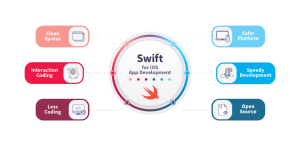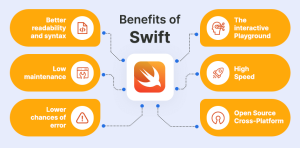Swift: The Evolution of Modern Programming
In the realm of programming languages, few have made an impact as swift and transformative as Swift. Developed by Apple Inc., Swift is a robust, open-source, and highly versatile programming language that has rapidly become the go-to choice for iOS, macOS, watchOS, and tvOS app development. In this comprehensive guide, we’ll delve into the world of Swift, exploring its origins, key features, applications, and why it’s a vital language for developers worldwide.
The Genesis of Swift
Swift was introduced to the world by Apple in 2014 at its Worldwide Developers Conference (WWDC). It was designed as a replacement for Objective-C, the primary programming language for Apple’s platforms at the time. The goal was clear: to create a language that would be more efficient, readable, and adaptable to modern programming paradigms while maintaining the performance and power of Objective-C.
 Key Features of Swift
Key Features of Swift
- Easy to Read and Write: Swift’s syntax is clean, concise, and highly readable. Its code is more similar to natural language, making it easier for developers to write and understand.
- Safety and Error Handling: Swift was designed with a strong focus on safety. It includes features like optionals and type inference to help developers catch and handle errors at compile time rather than runtime.
- High Performance: Despite its ease of use, Swift is incredibly fast. It was built with performance in mind, making it suitable for resource-intensive applications, including 3D games and augmented reality experiences.
- Interoperability: Swift is designed to work seamlessly with Objective-C. This means that developers can leverage their existing Objective-C codebase while gradually transitioning to Swift.
- Open Source: In 2015, Apple open-sourced Swift, inviting the developer community to contribute to its evolution. This move has accelerated Swift’s growth and adoption.
Applications of Swift
Swift is the language of choice for developing applications across the Apple ecosystem:
- iOS and iPadOS Apps: Swift is the primary language for building apps for iPhones and iPads. Its performance and ease of use have made it the preferred choice for mobile app development.
- macOS Apps: Developers use Swift to create desktop applications for Mac computers. macOS apps benefit from Swift’s speed and native integration.
- watchOS Apps: Swift powers apps for Apple Watch, enabling developers to build efficient and interactive experiences for wearable devices.
- tvOS Apps: Swift is used to create apps for Apple TV, offering users a seamless and engaging entertainment experience.
- Server-Side Development: Swift is not limited to Apple platforms. It’s gaining traction for server-side development, thanks to projects like Vapor and Kitura, which provide server-side Swift frameworks.
 Why Swift Matters
Why Swift Matters
Swift has had a profound impact on the world of app development, and here’s why it matters:
- Developer-Friendly: Swift’s user-friendly syntax reduces the learning curve for new developers. It encourages good coding practices and reduces the likelihood of errors.
- Performance: Swift’s speed and efficiency make it ideal for building resource-intensive applications that require real-time processing and responsiveness.
- Interoperability: The ability to work with Objective-C allows developers to seamlessly integrate Swift into existing codebases, making the transition smoother and less disruptive.
- Community and Support: The open-source nature of Swift has led to a vibrant community of developers who actively contribute to its development. This ensures that Swift remains up-to-date and well-supported.
- Cross-Platform Potential: While Swift is primarily associated with Apple platforms, initiatives like Swift for TensorFlow and server-side frameworks are expanding its reach beyond the Apple ecosystem.
Getting Started with Swift
If you’re ready to dive into the world of Swift, here’s how to get started:
- Install Xcode: Xcode is Apple’s integrated development environment (IDE) for Swift and Apple platform development. Download and install Xcode from the Mac App Store.
- Learn the Basics: Familiarize yourself with Swift’s syntax, data types, and basic concepts. Apple’s official Swift documentation and Swift Playgrounds are great resources for beginners.
- Build Small Projects: Start with simple projects to practice your skills. Create a basic iOS or macOS app, experiment with user interfaces, and gradually increase the complexity of your projects.
- Join the Community: Participate in online Swift communities, forums, and GitHub repositories. Engaging with fellow developers can help you learn and grow as a Swift programmer.
- Explore Advanced Topics: Once you’re comfortable with the basics, explore more advanced topics such as SwiftUI (for UI development) or Combine (for reactive programming).
Conclusion
Swift has revolutionized the world of app development, offering a powerful, intuitive, and versatile programming language for creating applications across Apple’s ecosystem. Its emphasis on safety, performance, and ease of use has made it a top choice for developers worldwide. Whether you’re an aspiring developer looking to start your journey or an experienced programmer seeking to expand your skill set, Swift provides an exciting platform to build innovative and impactful applications. Join the Swift community, harness its capabilities, and embark on a journey of creativity and development with confidence.

